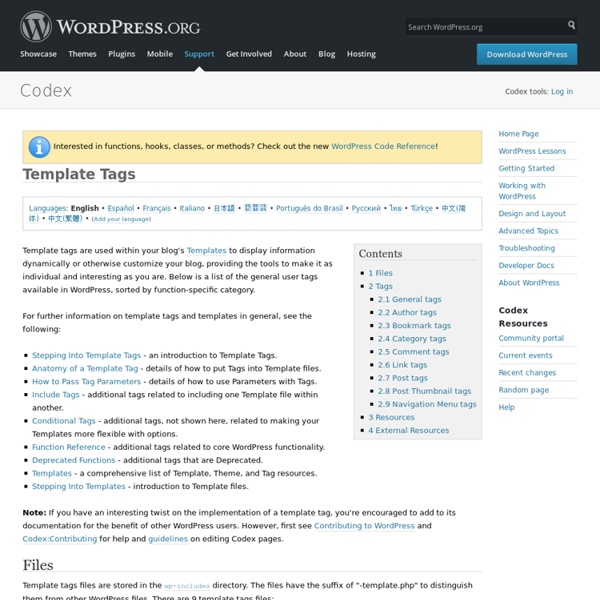About HTML semantics and front-end architecture
A collection of thoughts, experiences, ideas that I like, and ideas that I have been experimenting with over the last year. It covers HTML semantics, components and approaches to front-end architecture, class naming patterns, and HTTP compression. We shall not cease from exploration And the end of all our exploring Will be to arrive where we started And know the place for the first time. T.S. Eliot – “Little Gidding” About semantics
The Loop in Action
The Loop in Action Languages: English • Español • 日本語 • 中文(简体) • Українська • Русский • বাংলা • (Add your language) Introduction "The Loop" is the main process of WordPress. You use The Loop in your template files to show posts to visitors.
Book - Scalable and Modular Architecture for CSS
I have long lost count of how many web sites I’ve built. You would think after having built a few hundred of them I would have discovered the “one true way” of doing it. I don’t think there is one true way.
Templates
Templates Languages: English • Español • Italiano • 日本語 • Русский • (Add your language) Templates are the files which control how your WordPress site will be displayed on the Web. These files draw information from your WordPress MySQL database and generate the HTML code which is sent to the web browser. Through its powerful Theme system, WordPress allows you to define as few or as many Templates as you like all under one Theme.
WebZap - Photoshop panel plugin for web developers
Glossary
Glossary Languages: English • Español • Persian • Italiano • 日本語 • 한국어 • Português do Brasil • Русский • Slovenčina • 中文(简体) • 中文(繁體) • (Add your language) This document is designed to offer definitions for various terms, exclusive to WordPress, that users may not be familiar with. If you are a contributor please don't add definitions for generic terms (API, PHP, JavaScript, etc...). Absolute Path An absolute path or full path is a unique location of a file or directory name within a computer or filesystem, and usually starts with the root directory or drive letter.
Learn Web Development with the Ruby on Rails Tutorial
Installing WordPress Locally on Your Mac With MAMP
Installing WordPress Locally on Your Mac With MAMP What is MAMP? MAMP stands for Macintosh, Apache, MySQL, and PHP. MAMP is an application you can install on your Mac which allows you to have access to a local PHP server and MySQL server. Essentially, MAMP gives you all of the tools you need to run WordPress on your machine, for development and testing purposes. You can accomplish this in different ways, but the other ways aren't nearly as simple (see MacOS_X_Local_Mirror for the long, manual version of installing PHP and MySQL on your Mac).
How to Code a WordPress 3.0 Theme from Scratch
With the release of WordPress 3.0 came the implementation of many new features to the popular content management system. In this tutorial we are going to show you exactly how to code a WordPress 3.0 theme from the ground up to take advantage of all of these new features, as well as create a blogging-ready, minimal theme. Setting Up the Work Station To get started with this tutorial we should set up a server on our computer using either XAMPP or WAMP (usually if working on a PC), or MAMP if you are working on a Mac. All of these tools allow for a local testing environment for WordPress and can make it so that you don’t have to constantly transfer files through FTP while working on a project. In terms of code editing I would highly suggest Notepad++.
10 Fantastic Drag and Drop Page Builders for WordPress Worth Checking Out
Looking for a beautiful and responsive WordPress theme? View themes There’s been an explosion of WordPress page builders in recent months, so many in fact it’s hard to know where to begin.
How to Host your Website on Google Drive - Tutorial
This video tutorial explains how you can easily host websites on Google Drive with one click. You can even publish Drive website under a custom web domain using IFRAME. If you are looking for a place to quickly host your websites but don’t have access to any web server, Google Drive is a great alternative. You can use Google Drive to host basic websites or even complex JavaScript based web apps. You may upload and publish any kind of static content* on your website including HTML pages, images, CSS, icons, audio & video files including podcasts.
WordPress › Blog Tool, Publishing Platform, and CMS



